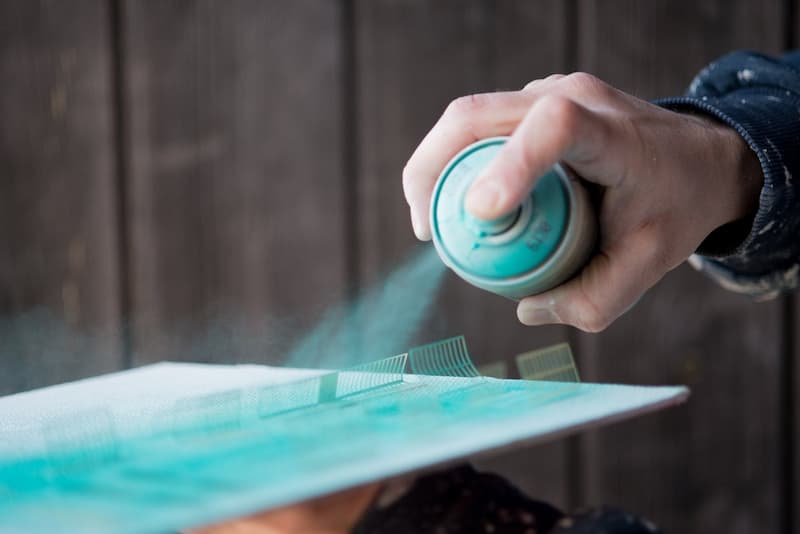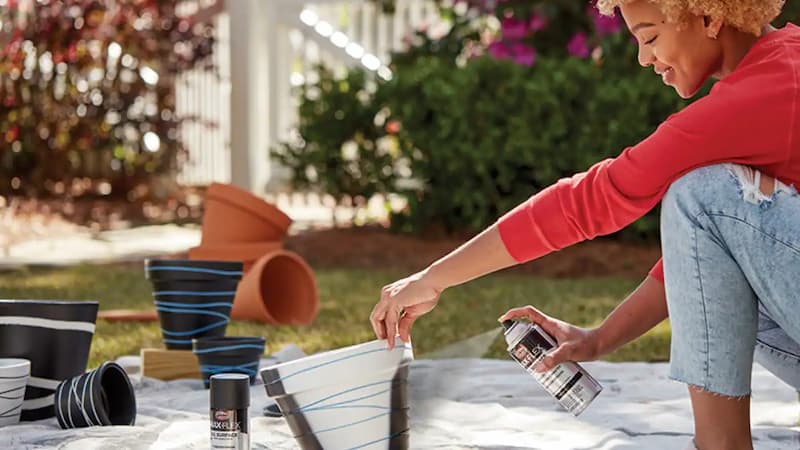Why is my spray paint cracking? Consider using spray paint to customize or fix a surface. Learn how to avoid cracking and other minor details.
Generally, spray paint is cracking because of Humidity Or Moisture and Thick Layering of Paint. Learn more about your errors and the causes of spray paint cracking by reading on.
Table of Contents
Why is My Spray Paint Cracking?
To begin with, let’s examine why spray paint crackles before moving on to how you can quickly fix your cracked spray paint. You can prevent accidents like this in the future by doing this.
Humidity Or Moisture
Make sure your workstation has the ideal temperature as one piece of advice. The surface of the target object will be wet if the temperature is too high and the humidity is high.
The surface of whatever you’re about to paint won’t ever adhere to the spray paint well if you don’t ensure a dry surface. Additionally, there is a good chance that the paint will crackle.
So what temperature do you think is ideal?
10 to 32 degrees What you want to watch for is a temperature in Celsius. Additionally, confirm that the humidity is under 85%.
Thick Layering of Paint
Spray paint should only be applied in layers after the first layer has completely dried. Be ready for a disaster if you overspray all at once and keep adding layers of paint.
When you apply too much paint to one spot, the paint layers won’t stick together. This will cause your paint to crackle and give you an uneven application.
Choose a number of lighter coats rather than one heavy one. Although it might seem time-consuming, the effort will be worthwhile. We promise!
To ensure that your paint never cracks, keep these two factors in mind. Additionally, prior to applying paint, make sure the surface of whatever you’re painting is thoroughly clean.

How Do You Keep Spray Paint from Crackling?
This is wholly dependent on the cause of the crackling. Spray painting in the recommended temperature range only will stop crackling from overly hot or underexposed surfaces. More layers sprayed on thinly is preferable to fewer layers that are applied excessively thickly. This stops the surface from drying out before the rest of the paint. Additionally, waiting longer than you anticipate can help prevent applying a second layer hastily before the first has dried.
Always do your research before mixing paints. This includes searching online to see if anyone has had success combining the two paints you want to use, as well as spray-painting a scrap piece to test the two paints’ adhesion. Prepping your desired surface properly by cleaning off dust and gunk is also advised, but
Spray Paint Cracking on Different Materials – Why & How to Avoid/fix It?
The ease with which it can be applied to so many different surfaces is one of the reasons spray painting is so well-liked. Few notable surfaces on which paint can be applied include metals, plastics, wood, mirrors, glass, and ceramics. However, there are slightly different rules for each surface; while some surfaces can get away without primer, others you should definitely prime before spray painting.
On Metal
Spray painting tasks often involve the use of metal. Use a small heater to warm up the object you are painting because temperature is frequently a problem. Metals can get quite cold, which makes it difficult for paint to adhere well. The surface must first be prepared and paint must be applied after the previous layer of paint has dried completely.
As important as the actual spray painting is the preparation of the metal surface. Make sure to use a primer and to prepare the surface by making it as smooth as possible. Both of these will ensure that the paint applies as evenly and smoothly as possible. To make sure the paint will apply smoothly, you should clean the surface with a wet cloth, take off any loose paint, and sand it down.
On Plastic
Plastic can have complex shapes with multiple surfaces because it is frequently used by hobbyists in home crafts. This makes spray painting more challenging because you’ll need to spray from various angles in order to get a perfect finish. Nevertheless, this makes it very simple to apply an excessive amount of paint, and crackling may occur in the areas where paint is applied in overlapping sections at different angles. Make sure to wait a sufficient amount of time between any two angles that could potentially overlap in order to avoid this. Simply delaying the application of the subsequent coat for a little while is always preferable!
On Wood
On wood, always use primers, and make sure it’s smooth. The best piece of advice for spray painting wood is that. Cracking on this surface is frequently caused by inadequate prior preparation. Wood can be rough and have tiny, protruding splinters if the surface is not smooth; properly sand it to avoid crackle. Before painting, primer is crucial for wood and should never be skipped because, in most cases, the absence of primer causes the wood to crackle.
On Glass
It’s not always necessary to use a primer when spray painting glass, but using many light coats will guarantee a smooth finish. The top layer of paint drying before the layers below causes crackling on glass, which frequently happens when too much paint is applied all at once. As the surface is already certain to be very smooth, spray painting glass can be very simple.
Similar to spray painting plastic, if you’re spray painting a vase or another object that is curved and necessitates awkward spray painting angles, crackling may result from applying too much paint in one area due to the use of multiple angles. Be sure to spray paint only after making sure that any nearby surfaces or previous layers are completely dry.
Why Does Spray Paint Crackle on Second Coat?
If you do not wait for your paint to dry, you risk getting crackling on the second coat or any subsequent coatings. Wet paint on top of wet paint will result from waiting too little. This indicates that the paint beneath the surface is not subject to the same cooling properties as the paint above, i.e. the external air, which means it won’t dry properly. However, the top coat of paint is drying flawlessly and will be finished soon. As the wet paint beneath the surface dries and moves, the surface will crackle over time.
Frequently Asked Questions
Can I Use Spray Paint on Natural Wood Surface?
On any kind of wooden surface, spray paint is indeed permissible.
Is It Possible That My Spray Paint Will Not Set on Metal?
Unfortunately, it is possible. Make sure to regulate the metal’s surface temperature.
Can I Put a Second Layer of Spray Paint on Plastic?
Yes, you can, just make sure the first layer is thoroughly dried out before applying the second layer.
Bottom Line
That’s all we have to say. We hope this post gave you a clear picture of how to fix spray paint crackle.
You can say goodbye to cracked paint by following these simple instructions and keeping a few suggestions in mind.
Have you ever experienced this issue? Do you have any advice that we missed? Please tell us in the comments section. Until then, don’t let your creative side die. Our goal is to clean up the mess.


